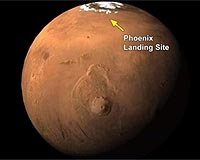 |
Pasadena CA (JPL) Jul 26, 2010 A camera aboard NASA's Mars Odyssey spacecraft has helped develop the most accurate global Martian map ever. Researchers and the public can access the map via several websites and explore and survey the entire surface of the Red Planet. The map was constructed using nearly 21,000 images from the Thermal Emission Imaging System, or THEMIS, a multi-band infrared camera on Odyssey. Researchers at Arizona State University's Mars Space Flight Facility in Tempe, in collaboration with NASA's Jet Propulsion Laboratory in Pasadena, Calif., have been compiling the map since THEMIS observations began eight years ago. The pictures have been smoothed, matched, blended and cartographically controlled to make a giant mosaic. Users can pan around images and zoom into them. At full zoom, the smallest surface details are 100 meters (330 feet) wide. While portions of Mars have been mapped at higher resolution, this map provides the most accurate view so far of the entire planet. "We've tied the images to the cartographic control grid provided by the U.S. Geological Survey, which also modeled the THEMIS camera's optics," said Philip Christensen, principal investigator for THEMIS and director of the Mars Space Flight Facility. "This approach lets us remove all instrument distortion, so features on the ground are correctly located to within a few pixels and provide the best global map of Mars to date." "The Mars Odyssey THEMIS team has assembled a spectacular product that will be the base map for Mars researchers for many years to come," said Jeffrey Plaut, Odyssey project scientist at JPL. "The map lays the framework for global studies of properties such as the mineral composition and physical nature of the surface materials." "The broad purpose underlying all these sites is to make Mars exploration easy and engaging for everyone," Christensen said. "We are trying to create a user-friendly interface between the public and NASA's Planetary Data System, which does a terrific job of collecting, validating and archiving data." Mars Odyssey was launched in April 2001 and reached the Red Planet in October 2001. Science operations began in February 2002. The mission is managed by JPL for NASA's Science Mission Directorate in Washington. Lockheed Martin Space Systems in Denver is the prime contractor for the project and built the spacecraft. NASA's Planetary Data System, sponsored by the Science Mission Directorate, archives and distributes scientific data from the agency's planetary missions, astronomical observations, and laboratory measurements.
Share This Article With Planet Earth
Related Links Odyssey spacecraft Mars News and Information at MarsDaily.com Lunar Dreams and more
 Mars Odyssey Still Hears Nothing From Phoenix
Mars Odyssey Still Hears Nothing From PhoenixPasadena CA (JPL) Mar 02, 2010 NASA's Phoenix Mars Lander showed no sign during February that it has revived itself after the northern Mars winter. NASA's Mars Odyssey orbiter will check again in early April. The solar-powered Phoenix lander operated for two months longer than its planned three-month mission in the Martian arctic in 2008. It was not designed to withstand winter conditions. However, in case the ret ... read more |
|
| The content herein, unless otherwise known to be public domain, are Copyright 1995-2010 - SpaceDaily. AFP and UPI Wire Stories are copyright Agence France-Presse and United Press International. ESA Portal Reports are copyright European Space Agency. All NASA sourced material is public domain. Additional copyrights may apply in whole or part to other bona fide parties. Advertising does not imply endorsement,agreement or approval of any opinions, statements or information provided by SpaceDaily on any Web page published or hosted by SpaceDaily. Privacy Statement |